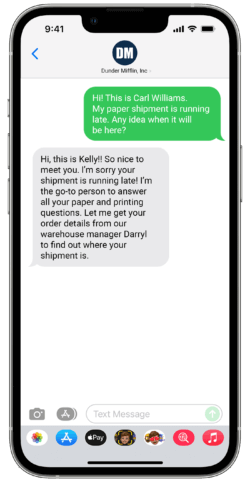
SMS Message Examples from the Employees of Dunder Mifflin Paper Company
Texting is part of our everyday lives. Even as I write this blog, I’m carrying on a texting conversation with my sister and my college friends, and just minutes ago used texting to verify my bank account. We’re so used to SMS messaging that most of us expect businesses to communicate with this channel too. In fact, 69% of all consumers want to communicate with a business via text.
Texting gives businesses a distinct advantage — it lets you interact with customers on a personal and convenient channel. To see how SMS messages fit in a business, we’ve imagined how the quintessential American office of Dunder Mifflin would have used business texting. What if the characters of NBC’s The Office had the texting technology we have today?
How Michael Scott would use SMS Messages
Ok, so maybe the “World’s Best Boss” would misuse access to SMS messaging at times. But even with Michael Scott’s (often stressful) craziness, we can imagine some practical uses for business texting.

Sending out Discounts and Coupons
What if Michael could have avoided the “golden ticket” debacle entirely? Instead of giving out a massive discount all to one client, he could have used SMS messages to connect with each winning client about their golden ticket coupon. Maybe it could have gone something like this:

Fundraising and Event Communications
Michael Scott’s Fun Run Race for the Cure would have been a bit more successful if he could have promoted the event to all of his clients simultaneously. Whether you’re fundraising or sharing info for an upcoming event, an SMS message is a reliable way to reach all of your customers at once. Instead of relying on the sales reps to ask incoming callers for donations, he could have contacted his clients using a mass SMS message and maybe could have raised more than $340. It could have gone something like this:

How this translates to your brand:
You don’t want to pretend to be Willy Wonka for a day to reach your clients. But use an SMS message to reliably reach customers selectively or on mass. Text messages have a significantly more successful open rate than other channels of communication, with a 98% open rate as opposed to just a 20% open rate with email. This lets you successfully reach your customer base when you run promotions or fundraisers.
How Kelly Kapoor would use an SMS Message in Customer Service
Kelly Kapoor — the queen of customer service — is a master at handling any customer stress that comes her way. She’s the go-to in the office when it comes to navigating complicated conversations. And you know she would be on top of the latest trends with SMS messaging. So we’ve imagined some ways that Kelly would use SMS messages to build relationships with customers and handle customer support. Here’s how:
Two-Way Customer Conversations

Kelly Kapoor is not wrong. When customers text you, they want you to text them back. Two-way conversations is one of the biggest benefits of using SMS messages. When you text your customers, you create a relationship that encourages flexibility and shows that you’re available to help them. We can count on Kelly to add in a bit too much personality. But if Kelly were to use two-way SMS messages, it would go something like this:

How this translates to your brand:
According to a recent survey, 63% of consumers would switch to a company that offers texting as a communication method. As Kelly showed us, business SMS messages make for an easy way to address follow-up questions or requests from your customers. It’s fast, personal, and can help to resolve inquiries quickly using the channel of communication we all feel comfortable with (especially Kelly).
When you offer text as a support option, you add convenience and flexibility. Customers can text with support departments while they’re at home, in the office, or running errands. With SMS customer support, the customer is in control.
Texting is also an extremely helpful asset for companies that have long-term client relationships — companies like Dunder Mifflin. Texting keeps a solid record for customer service so you can verify details from recent conversations or double-check important information like invoice numbers and address changes.
How Pam Halpert would use SMS messages

Every office needs someone sane to deal with the craziness of incoming communications and appointment and meeting schedules. Pam Beesley Halpert has to handle all the details and put up with whatever Michael Scott and Dwight Schrute are up to that day. That’s a lot of multitasking. For a receptionist, SMS messaging makes that multitasking simpler, allowing you to juggle all kinds of incoming and outgoing office communications simultaneously. Here’s how Pam would use an SMS message:
Scheduling Meetings:
SMS messaging can be useful for scheduling meetings and appointments — something Pam has to do a lot of for Michael. To avoid having to repeatedly answer phone calls, imagine Pam could use an SMS message to schedule those meetings. Maybe it would go something like this:

How this translates to your brand:
An SMS message system isn’t just useful for support or sales. It can be incredibly useful for managing business operations. As we can see with Pam, SMS messaging makes for a flexible way for your operations team to juggle meeting and scheduling communications in a way that integrates easily with your existing systems. Plus, since an individual person can have multiple text threads going at once, SMS messaging is more efficient than taking one phone call at a time.
Add business texting to reach customers effectively. And hopefully you’ll end up a bit more efficient than our friends at Dunder Mifflin.

